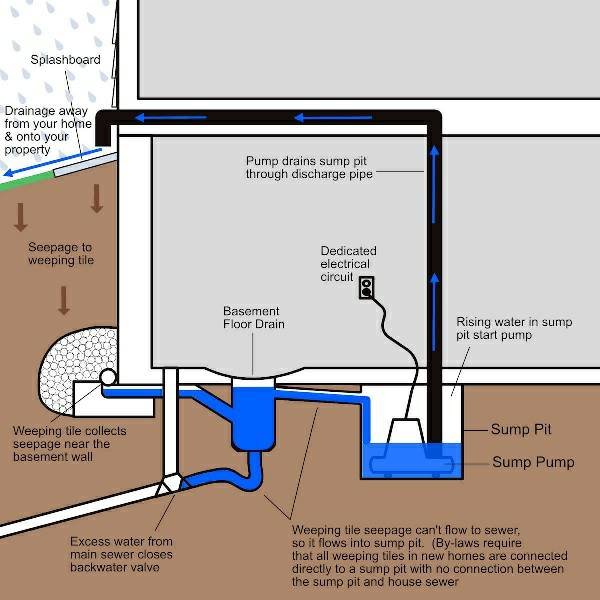Sump Pit Drainage Systems
Installation and maintenance
A sump pit drainage system includes a:
Sump pit – set into the basement floor, collects water from the weeping tiles around your basement.
Sump pump – pushes the water outside your house through the hose.
Discharge hose – drains the water out onto your property.
Install a backwater valve and sump pit drainage system
You should install this equipment if your home doesn’t have these features. For recently built homes, it's the law:
new homes built since 1979 are required to have backwater valves
new homes built since 1990 are required to have sump pits with pumps
This applies both to houses built in new subdivisions and to new houses in older neighbourhoods
Backwater valve
A backwater valve is a device that prevents sewage in an overloaded main sewer line from backing up into your basement.
The valve automatically closes if sewage backs up from the main sewer.
A properly installed backwater valve must be placed so that sewage backup is stopped and does not come out through other outlets in your basement, such as sinks, toilets, showers and laundry tubs.
With a backwater valve alone, weeping tiles connected to the sewer line can't drain when the backwater valve closes, causing water to overflow into your basement from the floor drain.
Sump pit
A sump pit drainage system includes a sump pit, a sump pump, and a pump discharge pipe.
The sump pit, set into the basement floor, collects water from the weeping tiles around your basement.
The pump pushes the water outside your house through the discharge pipe.
Place your sump pump discharge pipe so that it drains somewhere onto your property where water can be absorbed, such as your lawn or flowerbed.
Do not allow water from your sump pump to drain directly onto neighbouring properties, lanes, sidewalks, boulevards, streets, or into your home's floor drain or plumbing drainage system because this is illegal.
WATER AND WASTEWATER BY-LAW (21BL12)
Proper sump pump installation for homes built before 1990
Since part of the basement floor will be dug up and because the proper placement of these items is important, we recommend that you use a licensed plumber.
Research reputable contractors and ask friends and neighbours for referrals. We recommend that you:
Get at least three estimates
Ask for and check contractor references
Contact the Better Business Bureau for a reliability report on contractors
Check and maintain your backwater valve and sump pit drainage system regularly
Here are some things to do to make sure that your drainage system continues to operate properly.
Check the operating instructions for more detailed information and safety guidelines, or ask your plumber to explain the details of your system to you.
Backwater valve
Make sure that you can get to the valve at all times.
Check the valve regularly and remove any material that may prevent the valve from operating properly.
Sump pit
Clean the pit each year after freeze-up. Weeping tile drainage may carry small amounts of soil, sand and debris into the pit from around your basement.
Some water may remain in the pit and cause a musty smell if it sits for a long time. If so, you can flush the pit by adding fresh water until the pump removes the stale water.
Sump pump
Check and test your pump each spring before the rainy season begins, and before you leave your house for a long time. Pour water into the pit to trigger the pump to operate.
Remove and thoroughly clean the pump at least once a year. Disconnect the pump from the power source before you handle or clean it.
Check the pit every so often to ensure it is free of debris. Most pumps have a screen that covers the water intake. You must keep this screen clean.
Check and clean your catch basin/floor drain trap.
Sump pump discharge pipe
Check the place where the discharge pipe leaves the house. If the pipe is discharging right against the basement wall, the water will drain down into the weeping tiles and continue to recycle through the system.
Check the discharge point regularly to make sure that nothing is blocking the flow.
Contact your contractor for help if your pump runs frequently in the winter, and ice is causing hazardous conditions.


